Thursday, 23 June 2011
Distance 16 km
Duration 3 hours 35 minutes
Ascent 357 m, descent 90 m
Map 149 of the TOP100 lime-green series
Topoguide (ref. P691) Les Monts du Beaujolais et du Lyonnais… à pied

Relieved that the patter of rain on the tent had stopped during the night, we got up at 6:30 am, had a wash in the palatial shower block, and moved all our possessions off the wet grass onto the little tar road in front of our plot.
Bitumen is a wonderful substance for campers of our kind, without tables or chairs. There was no danger of being run over as we sat in the middle of the road eating our muesli – the place was like a graveyard at that hour.
There were two possibilities for today’s walk. One was to back-track through Cublize, up to the GR on the ridge, and follow it along to les Sauvages. The other was to press on along the lake to the big town of Amplepuis and then go up directly to les Sauvages. Although it meant losing even more height that would have to be regained, the thought of getting to a proper town, with proper bars and proper coffee, won the day. We were tired of disappointments.

By 7:30 we were on the road, a rather slimy dirt road, blocked off to cars. going along the shore of the artificial lake.
The trees were still dripping from yesterday’s downpour, but after a while we emerged from the forest into fields and came to the auberge which would have been our eating place last night. We thought wistfully of coffee, but everything was tightly closed.
The only activity was from a flock of newly-shorn sheep enjoying the morning sunshine.

Just past this we arrived at the dam wall and crossed it, rejoining the highway that we had left yesterday at the outskirts of Cublize. It was five uneventful kilometres from there to Amplepuis and with a cycle lane for us to walk in, we were not bothered by cars.
As we approached Amplepuis we wondered whether to take the big flat road to the right, or swoop up (past the grounds of a grand château) in the hope of finding the centre. A passing local pointed us up the uninvitingly steep road, and it turned out that the town was on a knoll between two small rivers, so the uphill pull was necessary.
We cut through some lanes towards the church and came out right in the middle of the shopping area, to our considerable relief.
There was a satisfying bustle of people and two bars, of which we chose the Café du Commerce over Le Sporting, on the grounds that we had always had a happy experience at places with the word “commerce ” in their name.
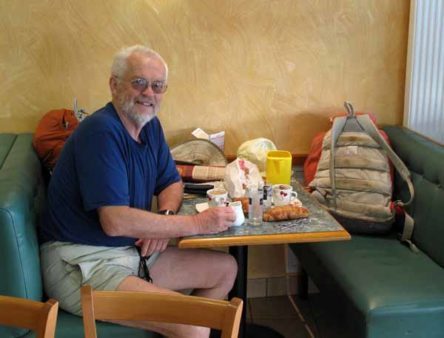
We were not disappointed, but before sitting down we stepped across the road and bought bread and croissants to accompany our coffee.
We also laid in some more lunch food – tomatoes, fruit and cheese – as we had eaten everything we had for our picnic last night.

Amplepuis has no great architectural gems – the church is a stout, pleasant, yellow-plastered pile – but its claim to fame is as the home of the inventor of the sewing machine, and a very worthy claim it is.
Barthélemy Thimonnier patented his invention in 1830 and set up a factory making army uniforms by machine, but he was up against the animosity of the local tailors, who were understandably afraid of losing their livelihood. There was riot in which his factory was burnt to the ground, and Thimonnier ended his days in obscure poverty.
Our plan was to follow the wide valley of the Ranconnet directly from Amplepuis up to les Sauvages, which was on the crest of the mountains. This valley carried the railway line and a fairly major road, the D8, but also a tiny local road on the other side of the stream, which looked enticing on the map.

We set off down the main street, descending as far as the railway line, but there was no sign whatsoever of the little road and we were obliged to take the big one. The lower part was easy enough, but as we rose, so did the gradient, with hairpin bends and cuttings.
We ignored a couple of opportunities to cross the stream and join the small road, as we could see that it was even more dismayingly steep than the main one.
It was just a matter of putting one foot grimly in front of the other, a task that I became slower and slower at. Keith waited patiently several times for his inadequate companion to catch up.
Quite suddenly the road flattened out and we found ourselves at the top, in the scattered village of les Sauvages, and right on the corner was the hotel St-Pierre.

We were pleased that we had booked ahead, a thing that we seldom do, from the Office of Tourism in Cublize and were assured of a bed.
When we entered, lunch was in full swing in the front room, but we eventually waylaid the manageress and gave our name. To our horror, she denied that she had anything booked for us – how could she, she said, she had no rooms to spare.
Some of the diners joined the conversation, suggesting that we should try the other hotel, about a kilometre away along the road, just before the descent to Tarare. What was the name of the hotel we were booked into? We had no idea, as it had all been done for us by the woman at the Office of Tourism.
It was all rather demoralising, even though one of the customers offered to drive us there (an offer which we naturally declined).
Mercifully it was quite a level walk and when we arrived at the second hotel, the Hotel de la Roche, in the village of le Charpenay, we were relieved to find that we were indeed booked in there.
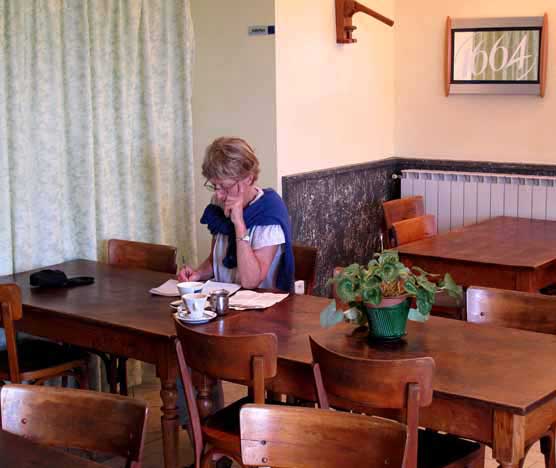
Our room was small but to us it seemed luxurious. The bathroom was down the corridor, a lot closer than it normally is in a camping ground, and we had a wonderful view of the plunging eastern side of the ridge.
After hot showers and a change of clothes, we had lunch sprawled on the bed, and then went downstairs for a coffee (with cream, as we had come to expect). After that we treated ourselves to a beer.
The main room was divided by a curtain, with the bar at the front and the more formal dining room at the back.
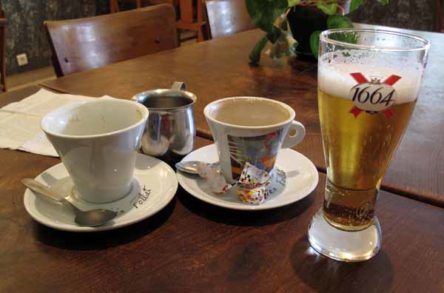
A tremendous din was coming from behind the curtain – shouting, laughing, clashing of cutlery and singing. We peeped through and saw a long table of ancients enjoying themselves.
We wondered whether it was a reunion of some partisan group from the war, these mountains having been a great hideout for the resistance.
When they finished eating, they continued to drink while various individuals told jokes, recited poems, or sang. Everyone joined in the songs – they all knew the words. Then another incredibly old man shuffled in from the street carrying his saxophone, which he proceeded to play very loudly and very badly. People were still singing but they were drowned out by the plangent honking of the saxophone, so at this point we left them to it and went back upstairs for a rest.

Below our window a flock of sheep rushed up and down the sloping field, pausing at each end to mill about boisterously until one sheep made a break for it and they all charged back again at top speed. We were reminded of a group of hysterical investors on the stock market.
Their bleating and the saxophone made an interesting duet floating in the window.
At 7:30 we went down for dinner, but before retiring behind the curtain, we sat in the front room to have an apéritif.
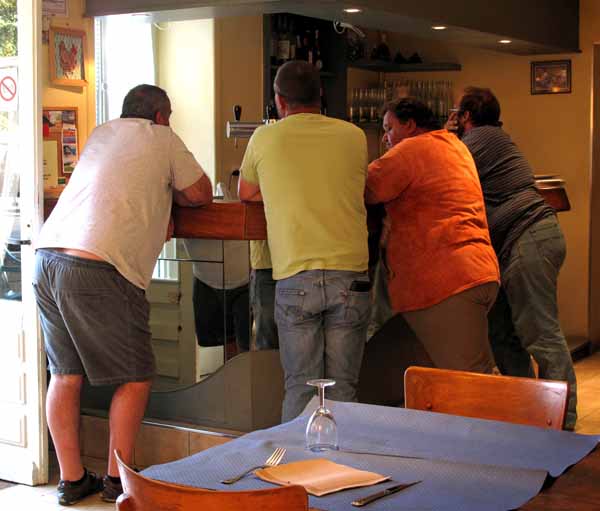
There were four vast backsides assembled at the bar, travelling workers of some kind. They were obviously regulars, as places were set for them in the front room rather than in the relative elegance of the back section.
We fell into conversation with a pair of beer drinkers who were on a hunting expedition in the area. It was a good chance for me to practice my French, which had been far from fluent so far this trip, and one of the hunters reassured me, saying it was perfectly acceptable to speak slowly, even though most French people did not. Indeed we have noticed that spoken French has the staccato rattle of a machine gun.
In due course we went behind the curtain to dine, but we drew it back a little so that we could have the company of the workers, instead of having to eat in solitude.
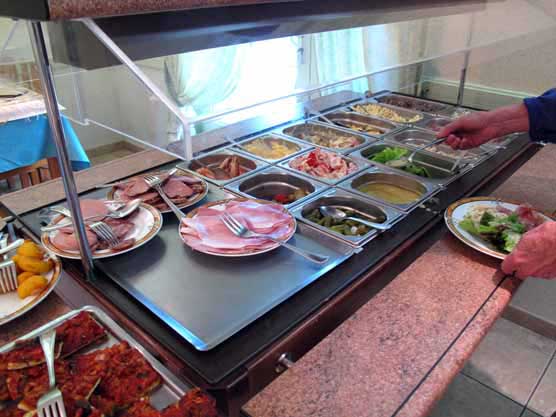
The fixed menu started with a magnificent buffet where we helped ourselves to salads and charcuterie of all kinds (some of which appeared as lunch food the next day).
Next we had roasted fowl with ratatouille and chips, then cheeses and finally a crème caramel.

By the time we had finished, our fellow diners had all disappeared upstairs and we quickly followed them. The combination of a proper dinner and a soft bed made for a night of deep, delicious sleep.
Previous section: Cluny to Cublize